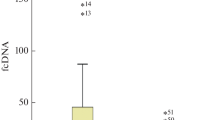Abstract
Increased levels of plasma DNA have frequently been noticed in the blood plasma of cancer patients. The possibility of using plasma DNA level as the indicator of tumor stage in breast cancer was investigated in plasma samples obtained from 100 breast cancer patients and 100 healthy women who were included as controls. Circulatory plasma free DNA was extracted from plasma samples and quantified by fluorometer. The median concentration of plasma DNA in the plasma samples from breast cancer patients classified by TNM staging system as stage I, II, III, IV and breast surgical patients were 0.5, 235, 422, 1,280 and 0.5 ng/ml, respectively. The level of plasma DNA in the stage II- IV group was significantly higher than those in the surgical group with breast cancer and control group (P value < 0.001). The plasma DNA concentration in stage II, III and IV of breast cancer were higher when compared with healthy group. These tumor size, TNM stage and metastasis were significantly correlated with plasma DNA. The cut point of 120 ng/ml was early screening and treatment follow up breast cancer.
Similar content being viewed by others
References
Attasara P, Buasom R. Hospital-based cancer registry. Bangkok: National Cancer Institute, Ministry Of Public Health; 2010. p. 3–4.
Zhong XY, Ladewig A, Schmid S, Wight E, Hahn S, Holzgreve W. Elevated level of cell-free plasma DNA is associated with breast cancer. Arch Gynecol Obstet. 2007;276(4):327–31.
Early Breast Cancer Trialist’s Collaborative Group. Systemic treatment of early breast cancer by hormonal, cytotoxic, or immune therapy. 133 randomised trial involving 31,000 recurrences and 24,000 deaths among 75,000 women. Lancet. 1992;339(8785):71–85.
Huang ZH, Li LH, Hua D. Quantitative analysis of plasma circulating DNA at diagnosis and during follow-up of breast cancer patients. Cancer Lett. 2006;243(1):64–70.
Donegan WL, Spratt JS. Cancer of the breast. Philadelphia: Saunders; 1988.
Leon SA, Shapiro B, Sklaroff DM, Yaros MJ. Free DNA in the serum of cancer patients and the effect of therapy. Cancer Res. 1977;37(3):646–50.
Vilenchik MM, Knudson AG. Inverse radiation dose-rate effects on somatic and germ-line mutations and DNA damage rates. Proc Nat Acad Sci USA. 2000;97(10):5381–6.
Rhodes A, Wort SJ, Thomas H, Collinson P, Bennett ED. Plasma DNA concentration as a predictor of mortality and sepsis in critically ill patients. Crit Care. 2006;10(2):R60.
Wang BG, Huang HY, Chen YC, Bristow RE, Kassauei K, Cheng CC, et al. Increased plasma DNA integrity in cancer patient. Cancer Res. 2003;63:3966–8.
Wong TS, Kwong DLW, Sham JST, Wei WI, Kwong YL, Yuen APW. Quantitative plasma hypermethylated DNA markers of undifferentiated nassopharyngeal carcinoma. Clin Cancer Res. 2004;10:2401–6.
Pathak AK, Bhutani M, Kumar S, Mohan A, Guleria R. Circulating cell-free DNA in plasma/serum of lung cancer patients as a potential screening and prognosis. Clin Chem. 2006;52:1833–42.
Hoeijmakers JH. DNA damage, aging, and cancer. N Engl J Med. 2009;361(15):1475–85.
Goebel G, Zitt M, Zitt M, Müller HM. Circulating nucleic acids in plasma or serum (CNAPS) as prognostic and predictive markers in patients with solid neoplasias. Dis Markers. 2005;21(3):105–20.
Holdenrieder S, Stieber P. Apoptotic markers in cancer. Clin Biochem. 2004;37(7):605–17.
Gormally E, Caboux E, Vineis P, Hainaut P. Circulating free DNA in plasma or serum as biomarker of carcinogenesis: practical aspects and biological significance. Mutat Res. 2007;635(2–3):105–17.
Zhao H, Shen J, Medico L, Wang D, Ambrosone CB, Liu S. A pilot study of circulating miRNAs as potential biomarkers of early stage breast cancer. PLoS One. 2010;5:e13735.
Garcia JM, Garcia V, Silva J, Peña C, Dominguez G, Sanchez A, et al. Extracellular tumor DNA in plasma and overall survival in breast cancer patients. Genes Chromosomes Cancer. 2006;45(7):692–701.
Acknowledgments
This research was supported by grants from the Naresuan University research fund. We thank Dr. Jirawut Puathachad, Faculty of Medicine, Buddachinaraj hospital department of surgery and Miss Watcharee Grisingdecha head of OPD department of surgery. We thank medical laboratory staff of Buddachinaraj hospital for excellent assistance. We thank the patients who participated in this study. Finally we sincerely thank Asst. Prof. Dr. Ronald A. Markwardt, Faculty of Public Health, Burapha University for his critical reading and correcting of the manuscript.
Author information
Authors and Affiliations
Corresponding author
Rights and permissions
About this article
Cite this article
Tangvarasittichai, O., Jaiwang, W. & Tangvarasittichai, S. The Plasma DNA Concentration as a Potential Breast Cancer Screening Marker. Ind J Clin Biochem 30, 55–58 (2015). https://doi.org/10.1007/s12291-013-0407-z
Received:
Accepted:
Published:
Issue Date:
DOI: https://doi.org/10.1007/s12291-013-0407-z




